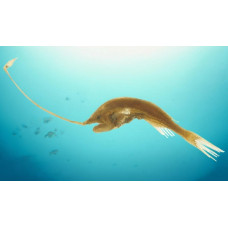Latin name
Gigantactis vanhoeffeni
Other name
Gigantactis exodon
Identification
The body form is short. Gigantactis vanhoeffeni features metamorphosed females, which are distinguished from other species in the genus by the length of the illicium (fishing apparatus). The illicium is relatively short, its length being less than 120% of the fish's standard length, and it becomes even shorter in larger specimens. The esca (lure) bulb has an elongated tip. This elongated tip is covered with spinules and exhibits dark pigmentation. Both the bulb and the elongated tip bear flattened papillae on their surface. The tip of the esca has short filaments near the end and slender filaments at the base. The illicium has a pair of thread-like projections near a slit on its posterior surface. Long teeth on the dentary bone are arranged in 3 rows.
Features of fish fins
Dorsal spines (total): 0; Dorsal soft rays (total): 6-7; Anal spines: 0; Anal soft rays: 6.
Fish colouring
Gigantactis vanhoeffeni has a dark coloration, such as black or dark brown.
Distribution
Gigantactis vanhoeffeni is found in the tropical and temperate latitudes of the Atlantic, Indian, and Pacific Oceans. It has been recorded as far north as Greenland.
Habitat
A marine, bathypelagic, deep-sea species. It inhabits depths ranging from 500 to 5,300 meters (approximately 1,600 to 17,400 feet).
Size
The maximum published total length for this species is 62 cm (24 inches).
Behavior
These fish may spend their entire lives in an inverted (upside-down) position. This posture likely makes it easier for them to manipulate their long lure, which hangs from the upper lip towards the seafloor. This strategy may aid in probing for prey hiding among bottom structures. The fish skillfully maneuvers the lure, moving it up, down, right, and left.
Food and feeding habits
Gigantactis vanhoeffeni feeds on cephalopods and crustaceans.
Reproduction
They are mostly solitary but may exhibit collective behavior during the breeding season, gathering in specific areas to search for partners.
Fishing
This species is not commercially important.
Relationship with a person
Harmless.
| Classification | |
| Phylum | Chordata |
| Class | Chordata |
| Squad | Lophiiformes |
| Family | Gigantactinidae |
| Genus | Gigantactis |
| Species | G. vanhoeffeni |
| Features | |
| Conservation status | Data Deficient |
| Habitat | Pelagic |
| Life span, years | No information |
| Maximum body weight, kg | No information |
| Maximum length, cm | 62 |
| Sailing speed, m/s | No information |
| Threat to people | Not edible |
| Way of eating | Planktonophage |
Gigantactis vanhoeffeni
Tags: gigantactis vanhoeffeni

